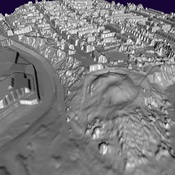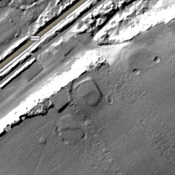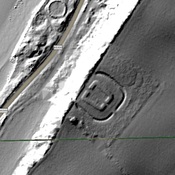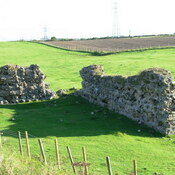The fort at Maryport formed part of the 'Western Sea Defences', a line of forts and watch-towers strung along the north-western coastline of Cumbria; a western extension of Hadrian's Wall. The fort is considerably larger than that necessary to accommodate the units which have been attested here. This surplus area has suggested to some scholars that Maryport may have been the administrative centre for the whole of the Western Sea Defences, but this cannot be proven.
The fort was built by legionaries from both the Second and Twentieth legions (see RIB 852 below), very likely at sometime during the reign of the emperor Hadrian (vide RIB 851 supra). Some building work was undertaken by the auxiliary regiment Cohors I Hispanorum (RIB 855) and possibly by their successors Cohors I Delmatarum (RIB 850). There was another spate of building in the middle of the third-century, this time by detachments from the Twentieth Legion (RIB 854).
VEXIL LEG II AVG ET XX V V FECERVNT
"Vexillations of the Second Augustan Legion and the Twentieth Legion Valiant and Victorious have made (this)" (RIB 8521; building inscription)
The most frequently attested unit at Maryport - and probably the first to occupy the fort - was Cohors I Hispanorum Equitata, a five-hundred strong part-mounted unit recruited from amongst the tribes of the Roman Spanish provinces. The Notitia Dignitatum indicates that by the turn of the fifth century, the unit had been moved on to Vxelodvnvm (Stanwix, Cumbria). Of the twenty-three altars to Jupiter found at Maryport (vide infra), ten are inscribed with the name of this regiment and a further six were dedicated by men known to have commanded the unit, which likely indicates that they were stationed here for a substantial period.
The second auxiliary unit identified at Maryport was Cohors I Delmatarum, a five-hundred strong infantry unit of Delmatae tribesmen from the Adriatic coast of modern Croatia. This regiment is attested on a number of inscriptions, two of them being positively dated to the reign of Antoninus Pius in the period AD138-61 (vide supra etiam infra).
Another auxiliary regiment which occupied the Maryport fort was Cohors I Baetasiorum, a five-hundred strong infantry unit of the Baetasii tribe from the area to the immediate west of Novaesium in Germania Inferior (Neuss, Westfalen, West Germany). This unit was originally stationed at the Bar Hill fort in the middle of the Antonine Wall, and moved to Maryport during the late Antonine period. The experience gained in the maritime environment here on the Cumbrian coast was later to see the unit posted to the Saxon-Shore fort at Regulbium (Reculver, Kent)2.
References
- ↑The Roman Inscriptions of Britain - Vol.1 - Inscriptions on Stone by R.G. Collingwood and R.P. Wright (Oxford 1965)
- ↑RBO: Alauna Carvetiorum
Das Kastell und seine Zivilsiedlung waren für mehr als 300 Jahre ein wichtiger Bestandteil der Küstenverteidigung am Solway Firth an der nordwestlichen Grenze des Römischen Reiches. Diese bestand aus einer Reihe von Kastellen, Kleinkastellen und Wachtürmen und diente als westlicher Flankenschutz des Hadrianswalls. Das Kastell war vermutlich Hauptquartier, sowie Nachschubhafen für die Garnisonen der Küstenkastelle und wohl auch Flottenstützpunkt. Die dortige römische Zivilsiedlung gilt als die größte, die bislang im Umfeld des Hadrianswalls entdeckt werden konnte.
Das Senhouse-Museum, untergebracht in einem 1885 von der Royal Navy errichteten Gebäude, verfügt über eine umfangreiche und international bedeutende Sammlung römischer Altäre und andere in Maryport oder seinem Umland geborgenen archäologischen Funde. Fünf dieser Altäre wurden von den jeweiligen Kastellkommandeuren gestiftet. Bei einigen von ihnen konnte man ihren Lebenslauf und Karriere teilweise rekonstruieren und ihre Stationen quer durch das römische Reich nachverfolgen.
Das Areal befindet sich heute in Privatbesitz, dennoch können seine Überreste von den umliegenden Straßen und Wegen aus betrachtet werden. Darüber hinaus kann man seine Besichtigung mit einem Besuch des Museums verbinden. Beim Museumsgebäude befindet sich eine – einem Limesturm nachempfundene – Aussichtsplattform, von wo man aus das gesamte Kastellareal überblicken kann.
Vom Kastell ist nur noch eine leicht erhöhte Erdplattform, direkt neben dem Senhouse Museum, zu sehen. Es hatte den für mittelkaiserzeitliche Festungen typischen rechteckigen Grundriss mit abgerundeten Ecken (Spielkartenform). Die nach Nordwesten ausgerichtete Anlage misst 135 Meter von Nord nach Süd und 139 Meter von Ost nach West. Der einzige noch sichtbare Mauerrest befindet sich neben dem Nordtor. Das Lager bedeckte eine Fläche von 2,58 ha. Seine Umfassungsmauern waren 1,80 Meter dick, und sind teilweise noch 3,1 Meter hoch erhalten. Sie waren durch innen angesetzte, quadratische Zwischentürme verstärkt und von mehreren Gräben als Annäherungshindernisse umgeben (vier an der Nordseite, drei auf der Südseite, zwei an der West- und Ostseite). Als Wehrgang diente eine rückwärtig aufgeschüttete Erdrampe. Betreten werden konnte das Lager durch vier Tore im Norden, Süden, Westen und Osten. Die Ecken waren zusätzlich mit innen angesetzten, langrechteckigen Türmen verstärkt. Die Zwischen- und Ecktürme sind noch als leichte Bodenerhebungen zu erkennen. Das Steinkastell ersetzte vermutlich auch den Wachturm 23B.
Innerhalb der Festung konnten nur die Positionen der Lagerverwaltung (Principia), des Kommandantenhauses (Praetorium) exakt bestimmt werden. Sicherlich verfügte es auch über mehrere Getreidespeicher (Horreum), Kasernenblöcke (Contubernia) und diverse Funktionsgebäude wie ein Bad (Therme/Balineum) Backstuben und Werkstätten (Fabricia).
https://de.wikipedia.org/wiki/Kastell_Alauna







